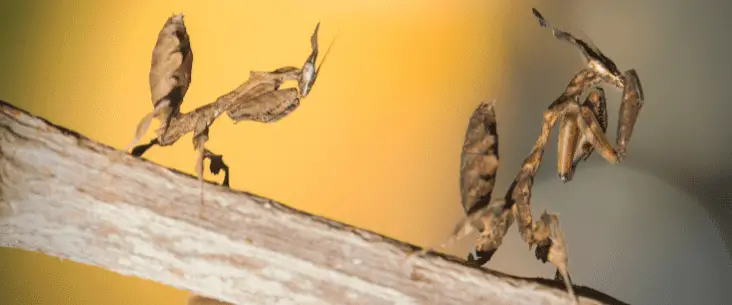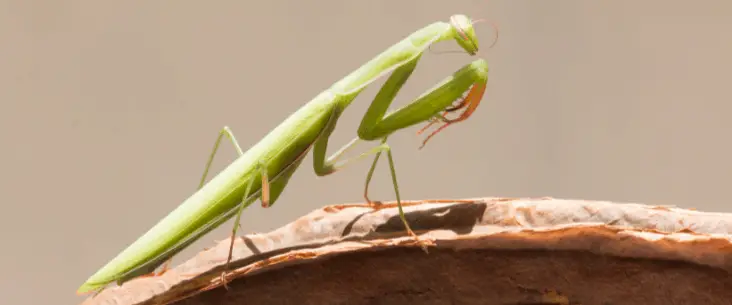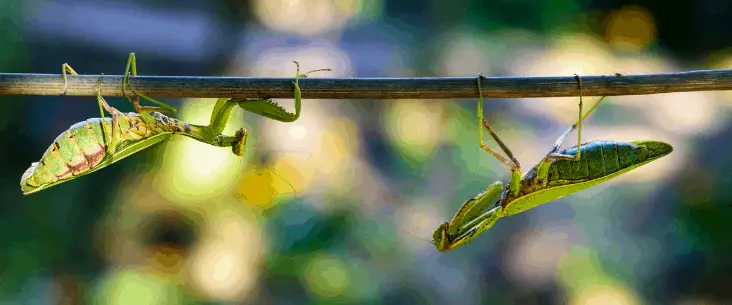Are you an absolute beginner in keeping praying mantis and wondering what the best species is to start with? Well, then you are on the right page. Keeping praying mantises can be a lot of fun and they are truly astonishing creatures. In this article, we will list the best praying mantis species if you have never kept a mantis before. In short below are the mantises that I and many other keepers recommend.
The best praying mantis species for absolute beginners are:
- Chinese Praying Mantis (Tenodera sinensis)
- African Praying Mantis (Sphodromantis lineola)
- Budwing Praying Mantis (Parasphendale affinis or P. argrionina)
- European Praying Mantis (Mantis religiosa)
- Giant Asian Praying Mantis (Hierodula membranacea)
- Ghost Praying Mantis (Phyllocrania paradoxa)
- Giant Shield Praying Mantis (Rhombodera sp.)
We discuss every species in more detail below what makes them such good praying mantis species for beginners. So check out if you find a species that suits your need!
What is the best praying mantis for beginners?
With over 2400 different species of praying mantis in the world and dozens of different species kept as pets, it may be difficult to choose which praying mantis to keep when you are a beginner. Every praying mantis has its own needs and some species are easy to keep, others are much more difficult.
The easier praying mantis species can accept a wider range of temperature and humidity. They are less sensitive and don’t have high requirements. Others are more fragile, more sensitive to environmental conditions and are pickier if it comes to food choice. With these species, it can be overwhelming to check all requirements. When you are new, it may be difficult to see all the details, understand all the needs and understand the behaviour.
Therefore, I recommend for absolute beginners praying mantis species that:
- Are calm and can be handled easily
- Don’t have high requirements or a need for special care
- Accept food easily
- Can be found in the pet trade regularly
So, the list below are the praying mantis species that I recommend for absolute beginners. It is based on my own experience and generally agreed upon by praying mantis keepers. The body sizes mentioned with every species are the size of the females. Males are generally smaller than females.
Recommended read: Basic guide on how to care for your praying mantis
7 praying mantis species that are good first pets
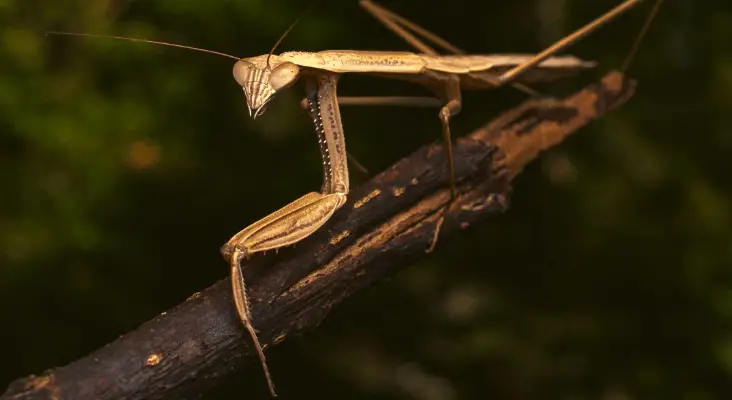
#1 Chinese Praying Mantis (Tenodera sinensis)
The Chinese praying mantis (Tenodera sinensis) is one of the most popular and widely available praying mantis species in the pet trade. And for good reasons. This species makes an excellent mantis for beginners. It’s really easy to care for, calm and easy to handle, and it can become quite large.
This species does not require much special care. They can thrive perfectly at room temperature and don’t need high humidity (although you should not keep them too dry). If you spray them 2 times a week is often more than enough.
This praying mantis original comes from Asia, as the name suggests, but now lives on multiple continents. They can survive in a large range of environments, and that makes them one of the best mantises you can get if you are an absolute beginner.
Chinese mantises are also often used as a classroom project because they are so easy to keep and can tolerate a lot. And of course, because you can handle them so well.
#2 African Praying Mantis (Sphodromantis lineola)
The African praying mantis (Sphodromantis lineola) is another great species for absolute beginners. They are really easy to take care of. It eats almost anything and readily accepts food from a tweezer. The only two reasons it is not on number one is that it needs a bit more heat, slightly higher than room temperature (although you can keep them pretty warm too), and are less available in the pet trade.
It is best to keep this praying mantis species around 25°C, although they do really well somewhere between 22°C and 30°C. It does not require much humidity, and when you spray 2 times a week will be sufficient. Don’t keep them too humid.
This species is not as big as the Chinese mantis, but still impressive with its 8cm adult size. Their body colour range between beige/brown to green. Brown variants have slightly purple eyes. The colour is adapted to its environment.
African praying mantis are fierce hunters and will actively hunt prey once spotted in the enclosure. It is beautiful to see this behaviour. However, they are really friendly and can easily be handled without problems.
#3 Budwing Praying Mantis (Parasphendale affinis or Parasphendale argrionina)
Although they are a bit more challenging to keep, many keepers agreed that the budwing praying mantis (Parasphendale affinis or Parasphendale argrionina) is great for beginners. They are beautifully coloured and are named because of their short wings that are used for display instead of flying.
These praying mantises are active predators and do not scare quickly. That makes them easy eaters and easy to care of. They need a warmer environment and the ideal temperature is around 26°C. They don’t need a humid environment. You only have to spray it twice a week for a little humidity and opportunity for them to drink. However, don’t keep them too humid.
Because there smaller body size they don’t need much space and an enclosure of a minimum of 15cm x 15cm x 25cm will do. However, they do really well in bigger enclosures because they are active hunters. So if you can keep them in a bigger space.
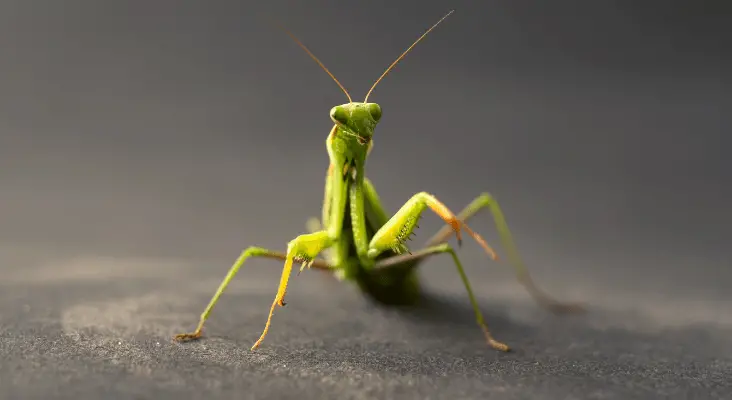
#4 European Praying Mantis (Mantis religiosa)
The European praying mantis (Mantis religiosa) is a great species to start with as a beginner. They need a slightly warmer temperature around 25°C but don’t have other special requirements. You only have to spray it twice a week to add some humidity in the enclosure and provide drinking water.
This species has a beautiful green body colour with some coloured patterns on the inside of the forearms. These mantises are still quite big with females of 8cm.
They are good hunters and are easy eaters, but they can be a bit harder to feed out of tweezers and like it more to hunt. When you release a prey in the enclosure they will actively chase it.
This species is less suitable to handle. It will be startled quickly when you come too close. It will show its impressive deimatic display.
#5 Giant Asian Praying Mantis (Hierodula membranacea)
The giant Asian praying mantis (Hierodula membranacea) is a great beginner species too. This mantis species is quite big with an adult size of up to 9cm (At least the females, males are a bit smaller). It is a beautiful species that normally have a green body colour, but there are also yellow, beige and brown varieties.
These species can thrive with room temperature (although they do better slightly warmer than room temperature) and when you mildly spray two or three times a week would be perfect. They don’t need a very humid environment and mostly need some water to drink. A too humid environment is unhealthy for this species.
This species eats almost anything and even the smaller nymphs quickly eat small crickets as prey. They are quite voracious hunters.
This praying mantis species can sometimes be harder to get in the pet trade. It is not always available. Also, it needs slightly more attention to climate conditions, but it still makes a great beginners mantis without any major problems.
#6 Ghost Praying Mantis (Phyllocrania paradoxa)
The ghost mantis (Phyllocrania paradoxa) is quite something else than the other mantis species mentioned above. They have body camouflage that looks like dried leaves. This species has a distinctive asymmetrical cone on its head. They are coloured dark brown to light brown to green, but the common colour is dark brown. The colour is influenced by the environment, and they tend to become greener when they are kept more humid.
This praying mantis species is a bit harder to keep because of its environmental needs. They need to be kept warm and humid. When you have set up a proper enclosure with an additional heat source and spray it quite often, they are still a great species to keep.
Another challenge is that this species is a sit-and-wait hunter. Their diet exists mostly out of flies and moths.
This species is quite calm and easy to handle and this praying mantis species is one of the few that can be housed in (small) groups if your housing is large enough and you feed them well. Normally you can house a single animal in an enclosure of 15cm x 15cm x 20cm, but with a group, you should use an enclosure with a size of at least 30cm x 30cm x 45cm.
If you are determined and read up on this species it still can make a great first praying mantis species. There are many keepers that had ghost mantises as their first pet.
Another great praying mantis species that can be housed in groups is the wandering violin mantis. However, this species is more difficult to obtain and you do not see them in the pet trade regularly.
#7 Giant Shield Praying Mantis (Rhombodera sp.)
Although maybe not the best praying mantis species for absolute beginners, they are beautiful animals and for the determined keepers, they may still be great pets. This species is amazing with its large shield appendage around its neck.
The giant shield praying mantis (Rhombodera sp.) is pretty aggressive and very cannibalistic. Always keep them solitary (except for breeding, which can be a challenge). It also needs a little larger enclosure because of its body size and activity.
They are quite good hunters and have a large appetite. So feeding them won’t be that difficult. However, they have higher demands on the environment. You’ll need to keep them slightly warmer than room temperature (around 23°C-24°C) and create a humid environment. So spraying the enclosure regularly with water.
Maybe this species is not exactly the one for absolute beginners, they are really beautiful and when you are determined to read up on this species you can have a great pet on this species.
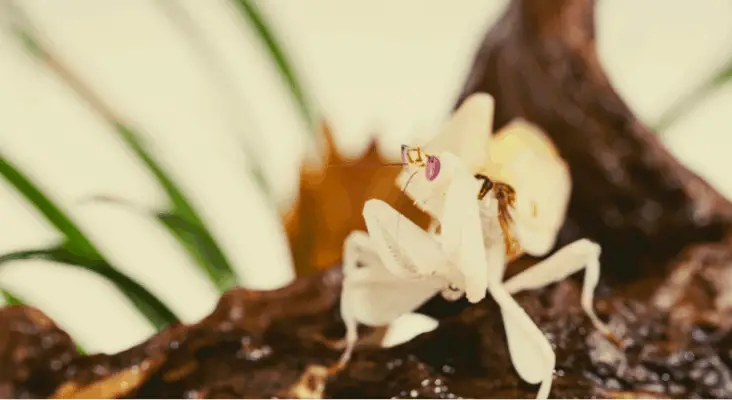
What about other praying mantis species?
There are many other praying mantis species to keep, but I recommend you to start with one of the species mentioned above. Other species have higher and more specific requirements, are more difficult to feed or have specific needs for food, or are just more fragile.
But I don’t want to discourage you to have the mantis species that you really want. I only want you to be prepared because it can be more of a challenge. For example, the popular orchid mantis, dead leaf mantis, devils flower mantis or spiny flower mantis are just not the best species for absolute beginners.
If you are really motivated, do the research it takes and talk to other mantis keepers (so do the necessary preparation), you could keep almost any praying mantis. Some species just need more attention and cost more work to keep.
Are praying mantis suitable for kids?
A praying mantis pet is only suitable for kids with the help of their parents. Praying mantis needs more attention and care than for example hissing cockroach or African millipede. It can be more difficult feeding them and praying mantises only accept live food.
However, the first two praying mantis species on the list above can still be a good pet for your kid if an adult will help with the care for them.
If you are in search of a pet that is suitable for your kid, I encourage you to read the article 7 coolest pet bugs for kids.
Related read: The Best Stick Insects For Absolute Beginners
Share this page!




